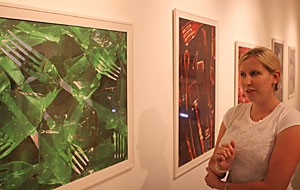Diane Keaton was one of the first to portray a career woman who struggled to find a balance between work and being a stay-at-home mom in 1987’s “”Baby Boom.””
Now more mediums, from reality TV to major art exhibits, are exploring and sometimes capitalizing on the subject. ABC’s “”Desperate Housewives,”” Bravo’s “”The Real Housewives of Orange County”” and an art exhibit right here on campus are all attempting to unravel what it means to be a so-called housewife today.
Fine arts graduate students Angela Harden-Wilson and Kristin Skees, who were introduced by a mutual professor, found solace knowing both were trying to figure out their roles as students, artists and newly married wives.
“”It is so great because when I met Angela, it was like OK, no, I’m not the only one feeling like this,”” said Skees.
Like Skees, Wilson was coping with her new identity.
“”My fear was being the housewife,”” Wilson said. “”It definitely gave me a lot of anxiety.””
While both Wilson and Skees express contentment in their relationships, they have both experienced angst in realizing the perfect balance between being “”Leave it to Beaver’s”” June Cleaver and being a career woman.
“”They say women of today want it all – the family, the career,”” Wilson said.
Both feel overwhelmed at the prospect of doing everything.
“”It is a lot, it’s perfection,”” Skees said.
Skees’ and Wilson’s exhibit, “”Disturbed Domestic: Housewife 2006,”” which utilizes photographs, videos and kitchen appliance installations to further illustrate the plight of housewives, paves the way in examining the role of a woman in modern society.
“”There is not a lot written about it because we are living it,”” Skees said.
The lack of anthropologic commentary on the subject matter may have contributed to the exhibit’s uniqueness.
Skees’ photographs in the exhibit consist of a posed unidentifiable husband and wife.
“”The husband is the one objectified, rather than the trophy wife,”” Skees said.
Wilson’s images include sugary sweets and doilies that she created in a darkroom without the use of a camera. The images evoke some of her frustrations and fears of being home more than her husband, who is currently working multiple jobs. As many can relate to, she eats while she does household chores.
The kitchen installations, which include a white refrigerator and shelves, create a blank canvas for the experimental videos that are placed within the various appliances.
It does not really matter who stays at home, but women naturally are more nurturing and tend to be more patient.Charlie Thomas,
economics freshman
Both women hope that although their audience might not relate to the ideas they are putting forth for discussion, the idea is to get young women’s minds thinking about what may be in the future.
As the two explore what a married woman in 2006 is supposed to do and be, they reiterate that they are in happy, loving relationships.
“”Someone came up to us and said, ‘you guys must really hate marriage,'”” Skees said. “”We love our husbands.””
Wilson concurrently defends herself against such charges.
“”A lot of people are anti-marriage. For us, it is not the issue with our husbands, it is the issue with our roles,”” Wilson said.
And while advertisements and popular sitcoms still enforce the typical housewife ideal, like Skees and Wilson, many UA students stand against the norm.
Psychology freshman Alex Berry, for example, grew up with her dad taking on the household duties while her mom was bringing home the bacon.
“”My dad would make my lunch and do the laundry while my mom was the one that made the money,”” Berry said.
“”I am not opposed to it being either the dad or the mom, it is a job either way and it is not easy.””
Economics freshman Charlie Thomas, said although he’s not opposed to a male being the household figure, he feels that the woman might be a better candidate for the job.
“”Honestly, it is still the same for a majority of households as it was 50 years ago,”” he said. “”I guess the right answer would be, the woman should attempt to bring in the money and be more independent, but it is not always true.””
“”It does not really matter who stays at home, but women naturally are more nurturing and tend to be more patient,”” he said.
Although Wilson and Skees are still figuring it all out through the process of creation, they seem to have a better grasp on who they are as married women.
“”We are wives,”” Wilson said. “”We don’t consider us ‘housewives.'””
Skees’ and Wilson’s exhibit will be on display until Sept. 15 at the Lionel Rombach Gallery. They will be holding a lecture tomorrow afternoon at 1 p.m. to speak about the exhibit and subject matter.









